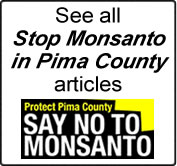Clearing Up Consumer Confusion about GMOs in Foods
A fast-growing movement of shoppers want to avoid genetically modified organisms (GMOs) in foods, but many are confused or lacking knowledge about how to steer clear of them. A new survey conducted by the Hartman Group found that 40 percent of consumers say they’re avoiding GMOs in foods. But less than one-third of them say they know which crops are most likely to be genetically engineered; only 28 percent say they know which products have GMO ingredients; and 57 percent are not yet aware of the Non-GMO Project Verified Seal!
Just as people who wanted to avoid gluten years ago learned which foods contained obvious – and hidden – sources of gluten before national labeling guidelines were enacted, people who want to sidestep GMOs need to learn the same type of in-depth information. I spell out these details in my recently published book Going Against GMOs. It’s important to learn the nine at-risk crops, plus two other main direct GM sources, and have that information become part of your everyday shopping know-how.
Learn Non-GMO Basics
An easy way to remember the nine GM crops that are commercialized and currently in our foods is to remember their initials: 3 Cs, 2 Ss, an A, a P, a Y, and a Z. The GM crops in that order are: Corn, Canola, and Cottonseed; Sugar Beets and Soybeans; Alfalfa; Papaya; and Yellow Squash and Zucchini. Two additional direct GM products are Aspartame (known as Nutrasweet) and rBGH (recombinant bovine growth hormone, which is injected into some dairy cows and found in some milk products).
Once you know the foods and products that are usually genetically engineered, the next step is to become knowledgeable about what kinds of foods contain those ingredients. Corn appears in countless forms, such as corn syrup, corn oil and cornstarch, in most processed foods, and it is also fed to livestock and poultry used for meat. Soy is found as soybean oil, soy sauce, tofu, and soy protein, and it’s also given as feed to animals. Sugar beets show up as beet sugar on labels, and that ingredient is hidden in virtually all foods that contain “sugar.”
To steer clear of GMOs, remove foods that contain these ingredients in their many forms, and eat foods that are labeled Non-GMO Project Verified or USDA Organic. (See the sidebar at the end of this article for more information.)
Think Beyond Just Non-GMO
There’s another kind of “mistake” people make when they’re trying to avoid GMOs: selecting non-GMO junk foods—or food allergens—that get them into other types of health trouble. For example, many people seek out foods made with Non-GMO Project Verified sugar. Shoppers tend to think of these foods as “safe” and end up eating these products with abandon. What people forget—or may not know—is that overconsumption of sugar, whether GMO or not, derails health over time: It suppresses immune function; feeds yeast and unbeneficial bacteria in the gut; and is regarded as an independent risk factor in cardiovascular disease, which includes heart attacks, strokes, and artery disease, as well as type 2 diabetes, liver cirrhosis, and dementia. Other non-GMO foods, such as refined vegetable oils and trans-fats, also promote disease in ways that have nothing to do with GMOs.
It’s important to understand that avoiding GMOs is only one part of a healthy eating plan. To promote optimal health, in addition to avoiding GMOs, I recommend ditching sugar and artificial sweeteners, whether GMO or not; being wary of corn, soy, and milk products, whether GMO or not; avoiding wheat and gluten and eating more non-starchy vegetables; steering clear of refined vegetable oils and trans-fats; and avoiding exposure to chemicals, including pesticides and food additives.
Following these guidelines while avoiding GMOs isn’t easy to do. But these recommendations are ones I gave my clients long before GMOs became such a huge and troublesome food issue. They’re guidelines that are just as important to follow now that so many of us are waking up to the risks associated with GM foods. Be sure to get a copy of my new book for all the practical information you need to know to successfully go non-GMO.
Copyright 2015 Melissa Diane Smith
Quick Tips for Being a Savvy Non-GMO Consumer
To prevent common mistakes when avoiding GMOs when you shop, build up your non-GMO knowledge and remember these points:
- Know by heart the main genetically modified items on the market. They are: Corn, Canola, and Cottonseed; Sugar Beets and Soybeans; Alfalfa; Papaya; Yellow Squash and Zucchini; plus Aspartame (known as Nutrasweet) and rBGH (recombinant bovine growth hormone, found in some milk products).
- Understand that non-animal-based whole foods that don’t contain the 11 at-risk ingredients are naturally free of GMOs. Examples include foods like asparagus, lettuce, onions, avocados, and blueberries. Realize, too, that although animals are not currently genetically modified, meat is often an indirect source of GMOs because conventionally raised animals are typically fed GMO feed, such as corn and soy.
- Look for the Non-GMO Project Verified seal and know what it means. Products that carry the Non-GMO Project Seal are verified to be in compliance with North America’s only third party standard for GMO avoidance, including testing of at-risk ingredients.
- Seek out organic foods. Products that carry the USDA Organic seal cannot intentionally include any GMO ingredients. Plus, they have the added bonus of being produced without most synthetic chemical pesticides and without other undesirable inputs such as sewage sludge.
- Don’t forget about your supplements. Read ingredient lists and avoid purchasing supplements that contain derivatives of common GM foods (i.e., cornstarch or soybean oil). Call or write manufacturers and ask them if their supplements contain GM ingredients. Or seek out a Non-GMO Project Verified supplement.


You must be logged in to post a comment.